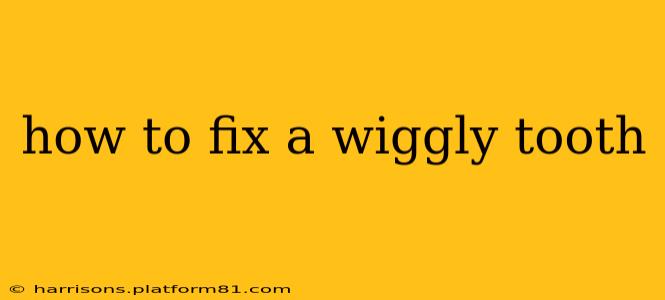A wiggly tooth is a rite of passage for most children, signifying the exciting transition from baby teeth to adult teeth. However, the experience can be unsettling, both for the child and their parents. This guide will explore the causes of wiggly teeth, offer advice on how to manage the process, and address common concerns.
What Causes a Tooth to Become Wiggly?
The primary reason a tooth becomes loose is the natural process of exfoliation, where the roots of baby teeth dissolve, allowing them to fall out naturally. This process is triggered by the developing adult tooth pushing the baby tooth upward and outward. The loosening is a gradual process, with the tooth becoming increasingly mobile before it finally falls out.
How Long Does It Take for a Wiggly Tooth to Fall Out?
The timeframe for a wiggly tooth to fall out varies considerably. It can range from a few weeks to several months. Several factors influence this timeframe, including:
- The individual child: Some children naturally lose their teeth quicker than others.
- The location of the tooth: Some teeth may be more firmly rooted than others.
- The development of the adult tooth: The pressure from the emerging adult tooth plays a significant role in the speed of exfoliation.
How to Deal with a Wiggly Tooth
The best approach to a wiggly tooth is generally patience and gentle care. Avoid excessive tugging or force, as this can cause damage to the gums or underlying adult tooth.
Gentle Wiggling is Okay, But...
A little gentle wiggling is usually harmless, allowing the child to assess the looseness themselves. However, forceful attempts to remove the tooth should be discouraged.
Maintaining Oral Hygiene
Maintaining excellent oral hygiene is crucial. Regular brushing and flossing help prevent infection around the loose tooth and promote healthy gum tissue.
When to See a Dentist
While most wiggly teeth fall out naturally, consulting a dentist is advised in the following situations:
- Excessive bleeding: If there is significant bleeding from the gums around the loose tooth.
- Severe pain or discomfort: If the wiggly tooth causes considerable pain.
- Delayed exfoliation: If the wiggly tooth remains loose for an unusually long time without signs of falling out and the adult tooth is not visible.
- Infection: Signs of infection, such as swelling, pus, or persistent bad breath.
What if the Tooth is Wiggly But Doesn't Fall Out?
In some cases, a wiggly tooth may not fall out naturally even after several months. If the adult tooth is present below the surface, the dentist may need to remove the remaining baby tooth to prevent complications with the adult tooth's eruption.
My Child Swallowed Their Wiggly Tooth! Is That Dangerous?
Swallowing a baby tooth is generally harmless. It's essentially the same as swallowing any other small piece of food. The tooth will pass through the digestive system without causing any harm.
Can I Help My Child Pull Out Their Wiggly Tooth?
While tempting to help, it's usually best to let the tooth come out naturally. However, if the tooth is extremely loose and the child is ready, you can gently apply pressure using clean hands. Always prioritize gentle handling to avoid injury.
Conclusion
Dealing with a wiggly tooth is a normal part of childhood development. With patience, gentle care, and good oral hygiene, the process will usually be smooth and uneventful. However, consulting a dentist is always recommended if there are any concerns or complications.
